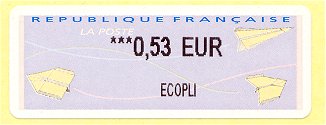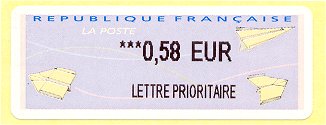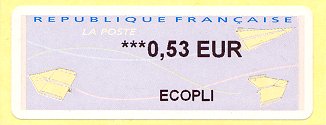| FRANCE. The new concept 'Espace Service Client'. The NABUCCO postal kiosks |
A new project, aimed at strengthening the post office availability and customer service, is the response of La Poste to a continued decline in customer satisfaction noticed around 2008. Later that year, the Groupe La Poste presented a strategic plan 'Cap Relations Clients 2015', aimed at improving customer service.
One of the highlights of the plan is the adaptation, by the end of 2011, of the 1,000 main post offices across the country to a new concept of selling space, called 'Espace Service Clients'. The final objective of La Poste is to reduce waiting times and offer a more personalized service, using agents to greet the customer on arrival at the post office, and assisting him/her according to their individual needs.
| The new post offices will become customer service areas, with postal products presented on display racks, and arranged in islands where the former counter agents, now transformed into advisors, can assist with all kinds of telephone, banking, ... and postal services ! These offices include priority areas for banking services and for professional clients, and the 'Espace automates' or 'Libre service', with its different self-service equipment, where customers can frank their mail at postal kiosks, withdraw money from the automated teller machines, or make photocopies. |
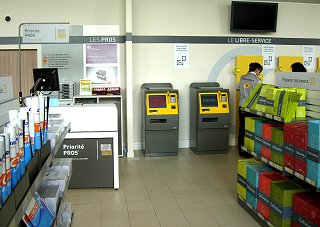 |
The adaptation of these post offices will involve, among other things, the need to increase the number of postal kiosks in service, and also the services offered to users through new software. To this end, La Poste, in June 2009, invited European based companies to tender for the supply of 5,000 new generation postal kiosks. In late November 2009, La Poste initially selected three suppliers who were asked to submit their prototypes. After a period of trials and negotiations, La Poste, in June 2010, signed contracts with two companies - The French IER, and the multinational Wincor Nixdorf.
The first new generation postal kiosks called NABUCCO (acronym for Nouvel Automate BUreau Courrier COlis) were delivered in late 2010, and installed in selected post offices.
The first machine by the IER company was put into public service on March 23rd 2011 in the Paris Sentier post office, and two days later, on March 25th, the first Wincor Nixdorf postal kiosk was installed in the Nantes Eraudière post office (right image).
The installation of hundreds of new NABUCCO postal kiosks, by both suppliers, in post offices across the country, began from the second quarter of 2011. These machines will be added, possibly until the end of 2013, to more than 5,000 IER LISA 2 postal kiosks already in service (fewer than 4,000 LISA 2 XP, and more than 1,000 LISA 2 Évolution kiosks). |
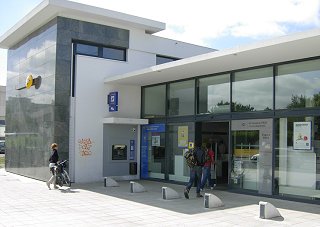 |
As far as the variable value stamps are concerned, all these postal kiosks print on the labels using thermal processes and use the same type of thermal self-adhesive labels, although it is possible to recognize differences in the impression they make, and the type of receipt issued. All postal kiosks in France use the same software and the same tariff program, which also establishes the text for the shipping indicators, and are updated remotely from the technical control centre.
 |
 |
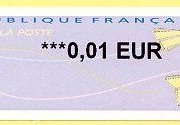 |
| IER LISA |
IER 950 - NABUCCO |
Wincor Nixdorf NABUCCO |
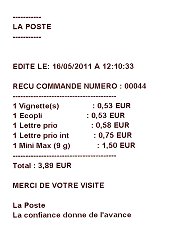 |
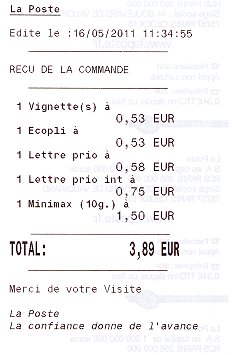 |
 |
| The new IER 950 - NABUCCO postal kiosk |
The postal kiosk manufactured by the IER company is a new-generation piece of equipment, a development of the LISA 2 machines, in service, but completely redesigned.
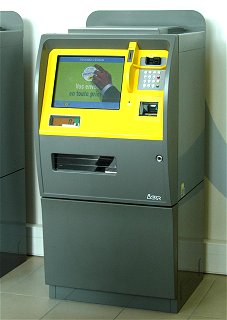 |
With regard to communication with the user, the 15'' LCD touch-screen of the new IER 950 kiosk offers greater possibilities than the 10'' screen of the LISA 2 machines.
Payment is possible with coins and bank cards. |
 |
The kiosk is also fitted with an RFID reader, and a barcode reader, allowing the mailing of international parcels through the 'Colissimo international' and 'Chronopost' services.
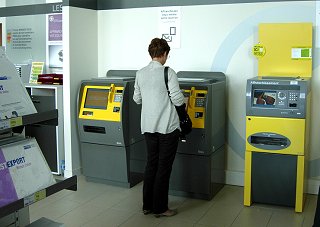 |
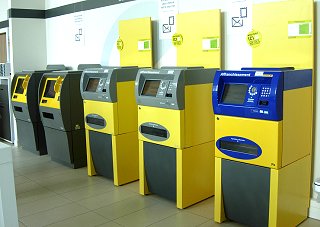 |
| Two new IER 950 postal kiosks installed at the Nantes Bretagne post office, along with two IER LISA 2 Évolution (grey and yellow) and one IER LISA 2 XP (blue and yellow) postal kiosks (right picture) |
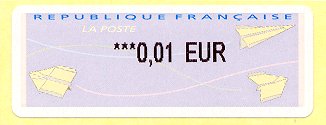 |
The print impression made by the new IER 950 - NABUCCO postal kiosks is similar to the LISA machines, although it is possible to recognize ATMs issued by the new kiosks, because the asterisks in front of the face value are smaller.
The images show the impressions appearing during their first few weeks in service. |
 |
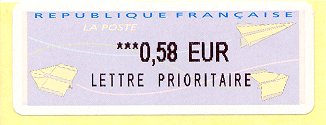 |
| Inland economic mail - ECOPLI |
Inland priority mail - LETTRE PRIORITAIRE |
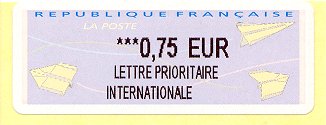 |
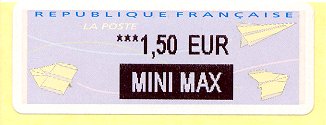 |
International priority mail
LETTRE PRIORITAIRE INTERNATIONALE |
Inland priority mail - Small parcels
MINI MAX |
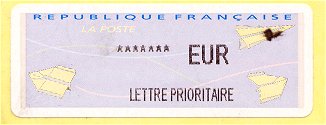 |
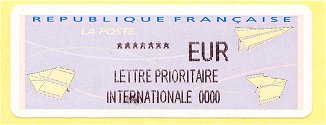 |
| Test imprints |
In mid June 2011, the control centre introduced some changes in the software, and since that date, the IER NABUCCO postal kiosks have printed the texts ECOPLI and LETTRE PRIORITAIRE using smaller characters.
| The new Wincor Nixdorf NABUCCO postal kiosk |
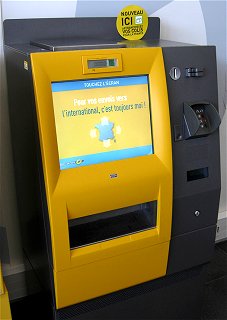 |
The postal kiosk supplied by Wincor Nixdorf has similar features and characteristics to the IER machines. In fact, both were especially developed from La Poste requirements. |
It too is fitted with a 15'' touch screen. On the right it has the payment module for coins and cards, and the scale is located on top. |
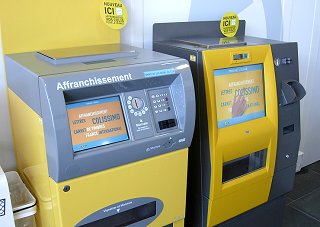 |
| Right, IER LISA 2 Évolution and Wincor Nixdorf NABUCCO postal kiosks |
 |
The impression made by Wincor Nixdorf NABUCCO distributors is easily recognizable and, at least during the first tests, proved to be of better quality. As in the previous case, the following images show the impressions made during the first few weeks in service. |
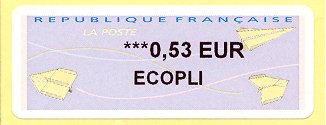 |
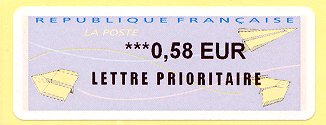 |
| Inland economic mail - ECOPLI |
Inland priority mail - LETTRE PRIORITAIRE |
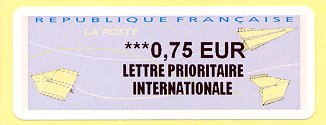 |
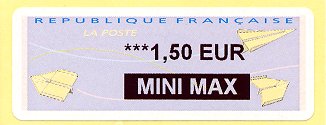 |
International priority mail
LETTRE PRIORITAIRE INTERNATIONALE |
Inland priority mail - Small parcels
MINI MAX |
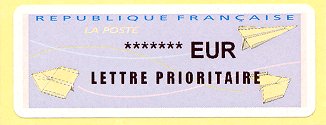 |
Wincor Nixdorf NABUCCO kiosks can print test labels with the different postal class indicators. |
 |
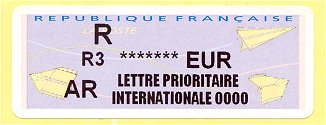 |
Following changes in the tariff program in mid-June 2011,the Wincor Nixdorf NABUCCO machines, in service, also changed the ECOPLI and LETTRE PRIORITAIRE text imprint - using smaller characters.
ATM Web - Spain and Latin American Postal Services: http://www.ateeme.net
© J. Jove - M. Sans. ATEEME. Variable value stamps study group. All rights reserved
This page was created in October 2011 and last updated:
17.10.11
. English edition rewritten by S. Goodman (14.10.2011)
|



















